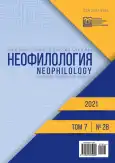Comparison as a way of emotional representation of information in advertising text
- 作者: Prigarina N.K.1
-
隶属关系:
- Volgograd State Socio-Pedagogical University
- 期: 卷 7, 编号 28 (2021)
- 页面: 743-749
- 栏目: КУЛЬТУРОЛОГИЯ
- URL: https://journal-vniispk.ru/2587-6953/article/view/302416
- DOI: https://doi.org/10.20310/2587-6953-2021-7-28-743-749
- ID: 302416
如何引用文章
全文:
详细
We investigate hidden comparisons that are relevant for advertising texts, created on the basis of lexical superlatives – marker words with an estimated value of high quality, superiority, originality, uniqueness, ideality, exemplaryness, etc. We show that the use of such hidden comparisons, not related to specific objects or phenomena, with which the advertised product/service is compared, is a striking feature of modern advertising texts. We substantiate that hidden comparisons created on the basis of lexical superlatives, demonstrating the advantages, superiority of the advertised goods/services over all others, increase the persuasiveness of the advertising text, enhance its effectiveness. We prove that hidden comparisons created on the basis of lexical superlatives provide emotional representation of information about the advertised object in the advertising text and perform a text-forming function, forming the dominant meanings of advertising.
作者简介
N. Prigarina
Volgograd State Socio-Pedagogical University
编辑信件的主要联系方式.
Email: prigarina99@mail.ru
ORCID iD: 0000-0003-3081-0533
Doctor of Philology, Associate Professor, Professor of Language Studies Department
俄罗斯联邦, 27 V.I. Lenin Ave., Volgograd 400005, Russian Federation参考
- Prokhorov A.V. Spetsifika vyvodnogo znaniya v reklamnoy kommunikatsii [Specifics of inferential knowledge in advertizing communication]. Vestnik Tambovskogo universiteta. Seriya: Filologicheskiye nauki i kul’turologiya – Tambov University Review. Series Philology and Culturology, 2016, no. 1 (5), pp. 25-28. (In Russian).
- Frolov I.T. (ed.). Filosofskiy slovar’ [Philosophical Dictionary]. Moscow, Respublica Publ., 2001, 719 p. (In Russian).
- Skovorodnikov A.P. (ed.). Entsiklopedicheskiy slovar’-spravochnik. Vyrazitel’nyye sredstva russkogo yazyka i rechevyye oshibki i nedochety [Encyclopedic Dictionary-Reference. Expressive Means of the Russian Language and Speech Errors and Shortcomings]. Moscow, FLINTA Publ., 2011, 480 p. (In Russian).
- Sheff I.A. Sravneniye kak ritoricheskaya kategoriya u Aristotelya [Simile as a rhetorical device in Aristotle’s rhetoric]. Indoyevropeyskoye yazykoznaniye i klassicheskaya filologiya – Indo-European Linguistics and Classical Philology, 2015, no. 19, pp. 996-1007. (In Russian).
- Dingilevskaya E.I. Voprosy sravneniya v trudakh logikov i lingvistov [Comparison issues in the writings of logicians and linguists]. Materialy 4 Mezhdunarodnoy nauchno-prakticheskoy konferentsii «Mir yazykov: rakurs i perspektiva» [Proceedings of the 4th International Scientific and Practice Conference “The World of Languages: View and Perspective”]. Minsk, BSU Publ., 2013, pp. 45-50. (In Russian).
- Parshchkova M.M. Sravneniye kak sredstvo obraznosti i vyrazitel’nosti v zarubezhnom yazykoznanii [Comparison as a stylistic and imaginative mean s in foreign linguistics]. Vestnik Yugorskogo gosudarstvennogo universiteta – Yugra State University Bulletin, 2017, no. 1 (44), pp. 16-21. (In Russian).
- Uvarova O.V. Osnovnyye napravleniya v izuchenii sravneniya [The main directions in the study of comparison]. Nauka i obrazovaniye – Science and Education, 2005, no. (40), pp. 136-140. (In Russian).
- Fadaee E. Symbols, metaphors and similes in the literature: A case study of “Animal Farm”. Journal of English and Literature, 2011, vol. 2, pp. 19-27.
- Hugh D. Symbols and Society. New York, Oxford University Press, 1969, 262 p.
- Ortony A. The role of similarity in similes and metaphors. Metaphor and Thought. Cambridge – London, Cambridge University Press, 1979, pp. 186-201.
- Pierini P. Simile in English: from description to translation. Circulo de lingüística aplicada a la Comunica ción, 2007, no. 29, pp. 21-43.
- Ritchie D. “Argument is war” – Or is it a Game of Chess? Multiple Meanings in the Analysis of Implicit Metaphors. Metaphor and Symbol, 2003, vol. 18 (2), pp. 125-146.
- Aniskina N.V. Sravneniye kak sredstvo vozdeystviya v reklame [Comparison as a means in advertizing]. Yaroslavskiy pedagogicheskiy vestnik – Yaroslavl Pedagogical Bulletin, 2014, no. 4, vol. 1: Humanitarian Sciences, pp. 189-193. (In Russian).
- Pirogova Y.K. Skrytyye i yavnyye sravneniya [Hidden and explicit comparisons]. Reklama i zhizn’ – Advertising and Life, 1998, no. 5, pp. 16-27. (In Russian).
- Shakhovskiy V.I. Ekologiya kommunikativnoy distributsii slova [Ecology of communicative word distribution]. Neofilologiya – Neophilology, 2021, vol. 7, no. 27, pp. 369-376. https://doi.org/10.20310/2587-6953-2021-7-27-369-376. (In Russian).
- Klemperer V. LTI – Lingua Tertii Imperii: Die Sprache des Dritten Reichs. Stuttgart, 2015, 384 S. (In German).
- Terskikh M.V., Bykova E.O. Reklamnye teksty kak ob"ekt lingvisticheskoy ekspertizy [Advertising texts as a linguistic expertise object]. Neofilologiya – Neophilology, 2018, vol. 4, no. 16, pp. 5-14. https://doi.org/10.20310/2587-6953-2018-4-16-5-14. (In Russian).
补充文件










